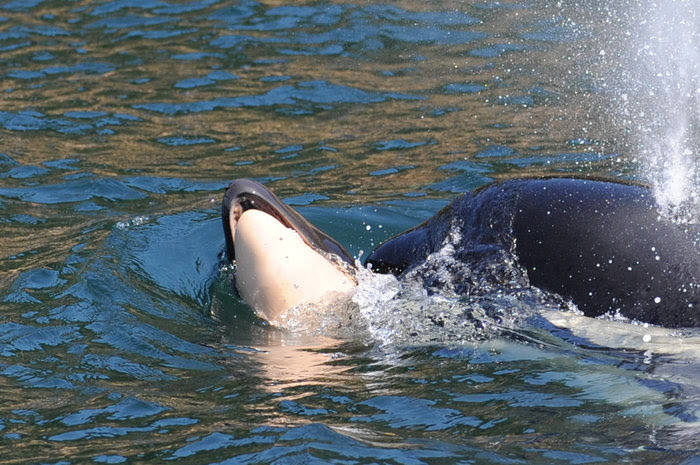The orca mother pushed her deceased baby to the surface of the choppy sea and carried it on her forehead in the direction of San Juan Island.
The mother known as J35 or Tahlequah, gave birth near Victoria, British Columbia on July 24. According to the Center for Whale Research, the newborn whale was reported alive and swimming with its mother and other members of J pod near Clover Point on the Victoria shoreline in mid-morning.
As Center for Whale Research staff headed to Victoria to photograph the good news, the calf was found deceased.
The Southern resident killer whales are comprised of three pods, or groups they live in, which are J, K and L. The newborn will not be added to the resident population because of its short lifespan. The Center for Whale Research reports that about 75 percent of newborns in the last two decades have not survived and 100 percent of pregnancies in the past three years have resulted in dead calves. Only 75 resident orcas remain.
The Center for Whale Research has been counting the population since 1976 when it was at its lowest at 71. The population reached near today’s count at 74 around 1985 but peaked at 98 in 1995.
The only silver lining for the residents is their long lifespans. Granny, or J2, the oldest known killer whale in the world, lived to be at least in her 80s. Even though new members are not being added to the pods, the current orcas may exist for decades to come.
Center for Whale Research founder Ken Balcomb is adamant that the resident orca population decline is from lack of Chinook salmon, which is their primary food source. Fraser River Chinook salmon are a large part of the orcas’ diet. One study from 2004-08 showed that up to 90 percent of the Chinook salmon consumed by the Southern residents, locally, originated from the Fraser River.
The Center for Whale Research website also states that of the “wild Chinook salmon populations associated with Puget Sound rivers, 16 are classified as extinct and the remaining 22 populations are listed as threatened.”
In early May, Washington Department Fish and Wildlife staff recommended all vessels avoid an area along the west side of San Juan Island to protect the endangered local orcas who are facing a shortage of prey and are known to feed in that location.
Last March, Washington state Gov. Jay Inslee also used an executive order to create a task force to protect both Chinook salmon and Southern resident killer whales.
County residents, including Balcomb, San Juan County Councilman Jamie Stephens and Washington state Sen. Kevin Ranker, D-Orcas Island, are part of the 46-member task force. The group will give final recommendations on how to protect the endangered orcas to the governor by November.
San Juan County staff are also implementing new tactics to protect the orcas, including offering whale warning flags, which are also used in Canada, by this July, to raise both on land and in boats when whales are nearby as an extra precaution.
For J35, who is still carrying her baby on her forehead, help for her species has not come soon enough. As of July 25, J35 was witnessed pushing the calf near East Point, Saturna Island, Canada. Orcas and dolphins have been known to support and transport their dead calves for as long as a week.
“It’s a testament to the amazingly strong mother and offspring bond and caring,” center staff wrote in a press release.
Before J35 departed for Canadian waters, a local resident reported a group of five to six female orcas gathered at the mouth of Eagle Cove near the Southern tip of San Juan as the sun set on July 24. For nearly two hours the whales formed a tight-knit circle, staying at the surface of the water. They appeared to be directly centered in the half-moon’s beam, even as it moved. The islander watching could not see if the baby was kept afloat but said the gathering looked like a ritual or ceremony.
“It was both sad and special to witness this behavior,” the islander said.
For more info, visit www.whaleresearch.com.




